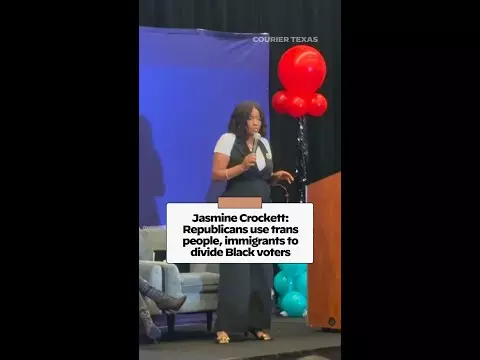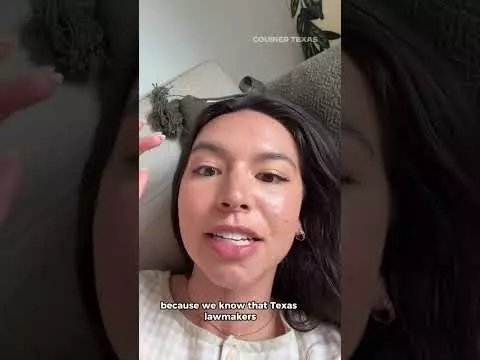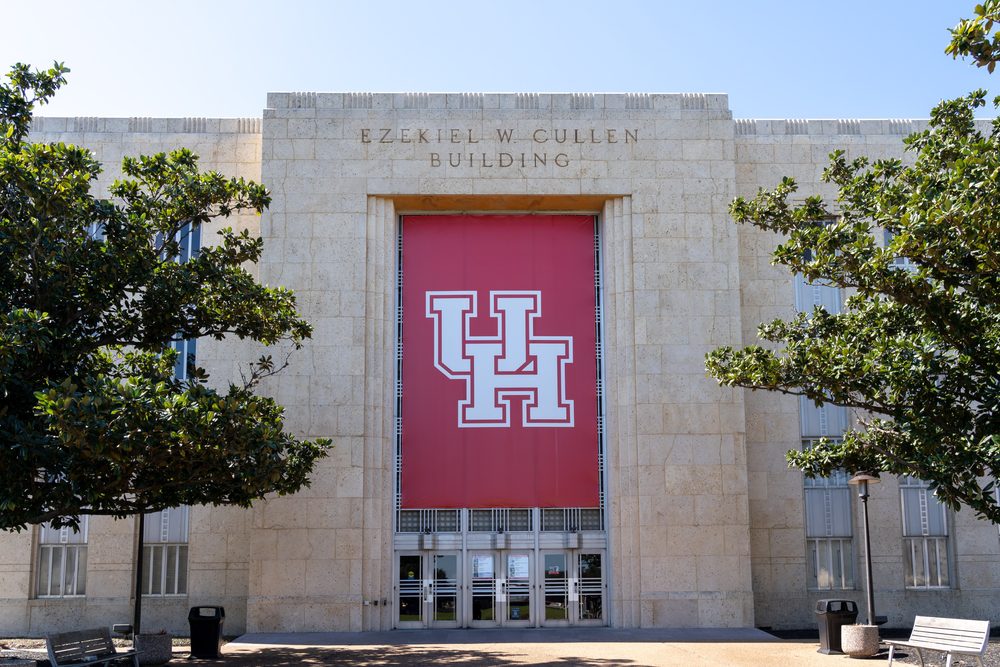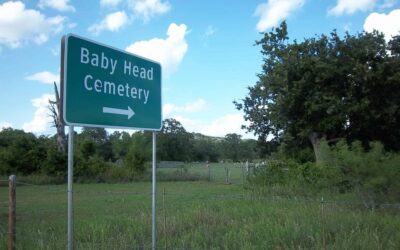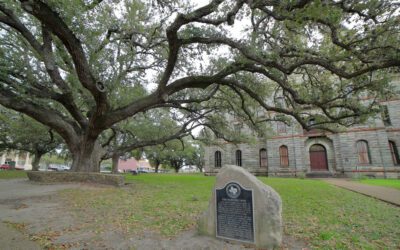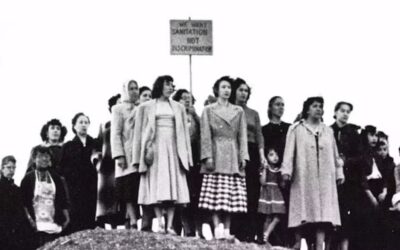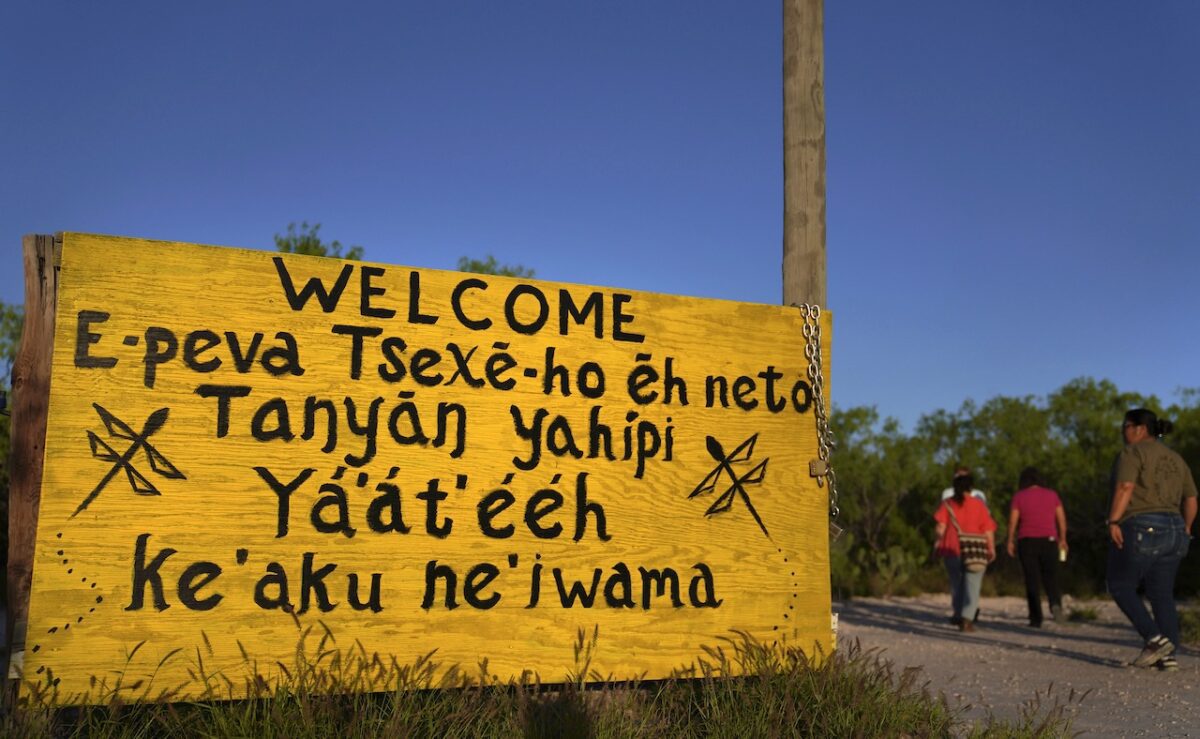
A welcome sign written in several different Native American languages at the entrance to the Indigenous Peyote Conservation Initiative homesite, led by several leaders within the Native American Church, in Hebbronville, Texas. (AP Photo/Jessie Wardarski)
Despite efforts to erase Native American history in the US, there are still active tribes in Texas and efforts to recognize the state’s Indigenous history and preserve the remaining communities. Nationally, Indigenous Peoples’ Day is now celebrated on the second Monday in October—what was once Columbus Day, until 1992, when the city of Berkley, CA decided to celebrate the former. More cities followed suit. National Native American Heritage Month is also observed in November.
When it comes to recognizing all Native nations, the country still has work to do. Some Texas lawmakers have tried over the years to help better acknowledge past tribes, including the city of Dallas renaming three man-made lakes to reflect the area’s Native history.
You are on Native land
In Texas today, there are three federally-recognized Indigenous tribes: the Alabama-Coushatta in Polk County; the Kickapoo Traditional in Maverick County; and the Ysleta Del Sur Pueblo in El Paso County. The Lipan-Apache tribe in McAllen is also currently active, but is not federally recognized. To be a federally recognized tribe means that the tribe has the right to self-govern, and that the tribe has a government-to-government relationship with the US.
Due to invasion by colonizers from Europe in the sixteenth century and beyond, many tribes in Texas were unfortunately wiped out by disease, resource takeover, and attacks from invaders. What we know now as the Texas Gulf Coast was once home to multiple Native tribes, including the Atakapa, the Karankawa, the Mariame, and the Akokisa.
Over in present-day West Texas, a tribe known as the Jumanos served as guides to Spanish explorers up until the early 1700s, when the tribe ended up assimilating with the Apache tribe due to invasion. The Coahuiltecan people took up most of the area known today as the Rio Grande Valley.
In the Southern Plains, centered by present-day Lubbock, the Comanche tribes migrated here from Colorado and Kansas in the late 1600s and early 1700s. While the Comanches ended up taking land control over from the Apaches, the fight for Texas independence and various diseases forced them into present-day Oklahoma. The Tonkawa tribe was also forced into Oklahoma out of central Texas, and now reside as a federally-recognized group.
North Texas was originally home to many tribes, including the Caddo, the Comanche, the Kiowa, the Tawakoni, and the Wichita. However, the 1841 Battle of Village Creek, which happened near Fort Worth and Arlington pushed many Native Americans out of North Texas. In 1956, the Indian Relocation Act actively encouraged Native people to urban cities like Dallas. This brought over 10,000 people to the city. Currently, Native Americans and Alaska Natives make up .08% of the population in Dallas, or around 1,042 people.
Currently, there are 574 federally recognized tribes in the US today. To be officially recognized, tribes must meet seven mandatory criteria, including being a Native American tribe since at least 1900; has maintained political influence over its members; the majority of the group has existed as a community from historical times until the present; and has provided documentation of membership criteria, among other things.
Preserving sacred history
The Texas Tribal Buffalo Project, a nonprofit organization, is the first Native women-led organization in Texas.
“We are restoring kinship between Texas Indigenous Lineal Descendants and our Buffalo relatives through ancestral governance, cultural resilience, and deep care for the Land,” the website states.
Along with healing generational trauma for Lipan Apache descendants and connecting Texas Indigenous Lineal Descendents to each other, the nonprofit also has five core initiatives and programs they focus on.
The five programs include initiatives to provide bison meat to expecting mothers, incorporate Indigenous food into school meal programs, and sending out an Indigenous survey.
If you’re looking to contribute to the preservation and continuation of Native culture in Texas and the US, check out the organizations below..
- Native American Rights Fund
- Indian Land Tenure Foundation
- Trust for Public Land
- First Nations Development Institute
- Native Americans in Philanthropy
- The Texas Tribal Buffalo Project
KEEP READING: Learn all about the coastal tribes that once inhabited Houston




